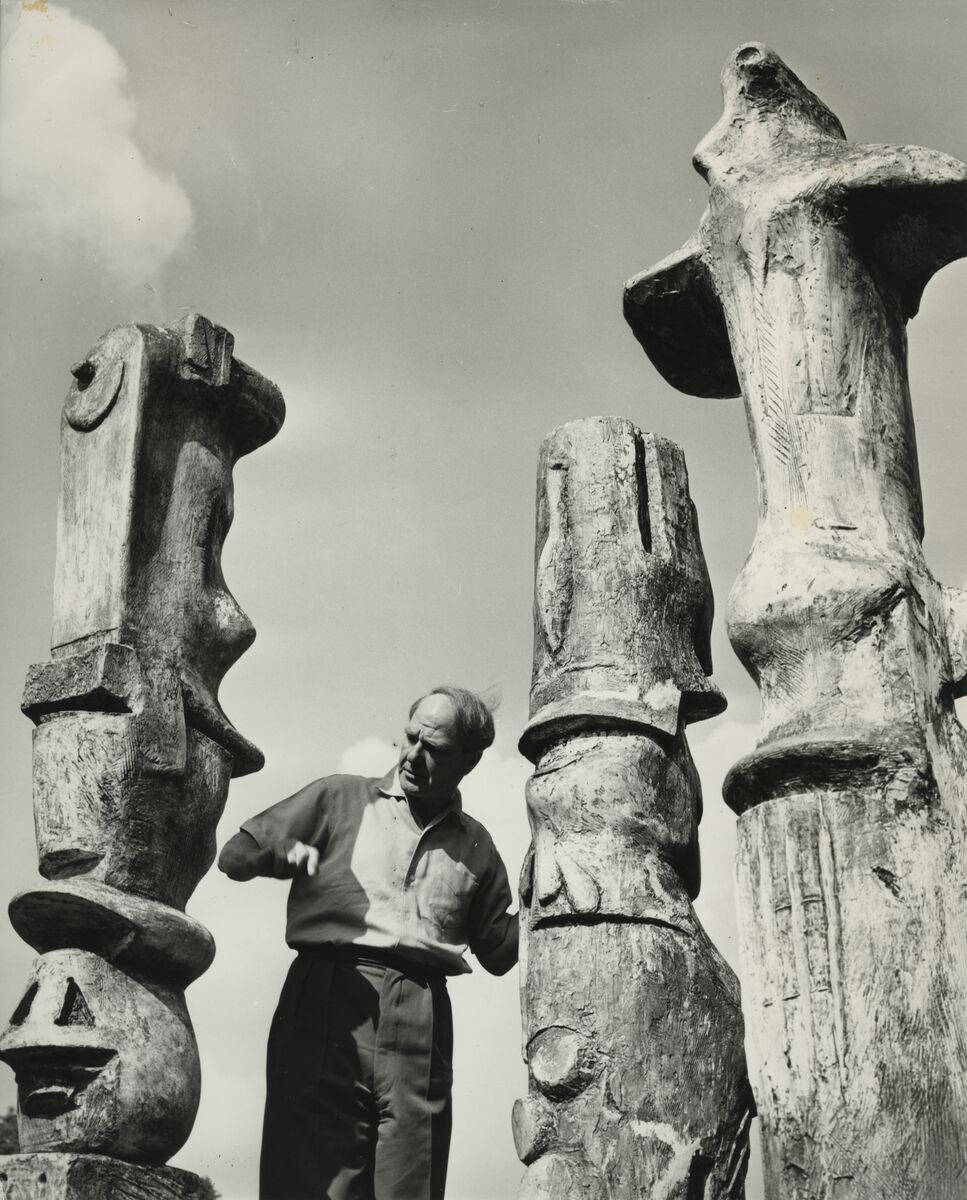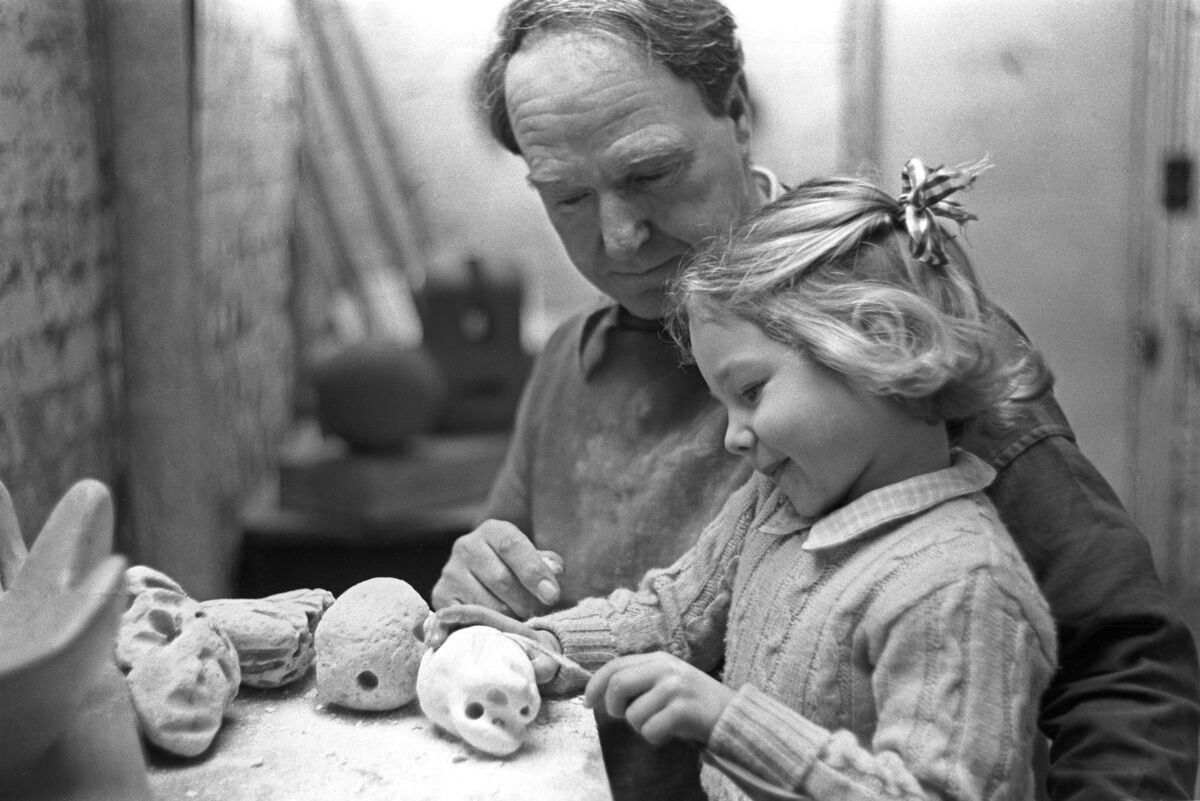Teachers’ Notes: ‘Henry Moore. Sharing Form’

Henry Moore with three of his Upright Motives ca. 1955. Photo: Barry Warner
Teachers’ Notes: ‘Henry Moore. Sharing Form’
This resource has been produced to accompany the exhibition ‘Henry Moore. Sharing Form’ at Hauser & Wirth Somerset from 28 May – 4 September 2022.
About Henry Moore
Henry Moore is celebrated as one of the most important British sculptors of the 20th Century. His career spans over 60 years, during which time he worked in a wide range of materials and a variety of subjects and references.
Moore was born in 1898 in Castleford Yorkshire. He was the son of a miner and the seventh of eight children. Moore was determined to be a sculptor from a young age but his father, Raymond, insisted he attend teacher training college, so that he would have the security of a professional qualification. Moore did not enjoy teaching and, in 1917, he enrolled in the British Army.
After the war, thanks to an ex-serviceman’s grant, he was able to realise his ambition to become an artist. He studied first at Leeds School of Art (1919 – 21) and then the Royal College of Art (RCA). He taught at the RCA from 1925 – 32 and at Chelsea School of Art from 1932 until the Second World War broke out in 1939. In 1940, after the bombing of his studio in Hampstead, he moved to Much Hadham in Hertfordshire, where he lived for the rest of his life.
Moore’s preferred method for making sculpture was carving. In the 1920s and 30s, he rejected the academic tradition of modelling in favour of the principles of ‘direct carving’ and ‘truth to material’. From the mid 1940s, his adherence to these doctrines had relaxed and bronze replaced stone and wood as his most frequently used material. The properties of bronze allowed for a greater variety of shapes and forms, and for him to work on a monumental scale.
Drawing was also extremely important to Moore. He spoke about drawing as a way of making you ‘look more intensely’. Drawing from life was an integral part of his training. It was his drawings of people sheltering in the London underground during the Second World War that secured his reputation and resulted in, post-war, several public sculpture commissions in Britain and abroad.
Having achieved global fame and success, in 1977 Moore decided to establish The Henry Moore Foundation together with his wife Irina and daughter Mary. He died in 1986. Moore’s work is represented in collections of modern art throughout the world; at Tate Modern, London, two rooms are dedicated to display over 30 of his works.
This major exhibition of works by Henry Moore is curated by Hannah Higham of the Henry Moore Foundation in collaboration with the artist’s daughter Mary Moore. ‘Henry Moore. Sharing Form’ is a comprehensive survey spanning six decades and extends across all five gallery spaces, in addition to an open-air presentation of seminal works.
Stonehenge I lithograph in three colours 1973 (CGM 208). Photo: Michael Phipps
What are the major themes within the exhibition?
Stonehenge
The exhibition takes Moore’s visit to Stonehenge in 1921 as its starting point. Moore arrived at the prehistoric monument at night and so first experienced the rings of the standing stones by the light of the moon. His first impression was so powerful that 50 years later, in 1973, when he decided to make a series of lithographs depicting the site, he showed it bathed in moonlight. He was fascinated by the towering masses of ancient stone and viewed the site as a work of art, capable of producing a powerful emotional response.
Between 1955 and 1979, Moore created nine large scale ‘Upright Motive’ sculptures which are being exhibited in the Threshing Barn. Each work combines different natural, human and mechanical forms and grouped together are reminiscent of prehistoric monoliths.
Human figure
The human figure is core to almost all of Moore’s work. He is widely known for his Reclining Figures and motif of the mother and child, but even when his work becomes more abstract, the figure was often central to his thinking. In this exhibition, many sculptures relate to natural forms, but also to how our bodies relate to the landscape around us.
Internal and external
Moore repeatedly explored the theme of internal and external forms, enjoying the opportunity to present one form through another. Inspired by human and natural structures such as shells, seed pods, and skulls, Moore associated internal and external forms with ideas of growth, nurture and protection.
He was also influenced by visits to museums where he saw helmets or stringed mathematical models. Moore used string in his sculpture, often combining it with curvilinear mass, to simultaneously reveal and enclose space.
Henry Moore, Helmet Head No4: Interior-Exterior, 1963. Bronze (LH 508). Photo: Nigel Moore
Landscape
For Moore, the forms of Stonehenge were direct and elemental, but they also made reference to a social form of art in which people were directly connected with the landscape. Moore himself liked to take long walks in the countryside, as he had as a child in the rocky landscape of the Yorkshire Dales. The body in Moore’s work was frequently a metaphor for landscape.
Natural forms
Inspiration for Moore’s sculptures came from a number of natural sources such as bones, stones, shells and pieces of wood, which he amassed in his studios at Perry Green. The Pigsty Gallery features objects, curated by his daughter Mary Moore, from her father’s lifelong collection of natural forms accumulated from beaches, fields and vegetable beds. It also includes works selected from Moore’s ethnographic collection, which populated the artist’s family home.
Volume and space
The works exhibited in the Rhoades Gallery explore the relationship between gravity and weight, volume and space. Figures emerge from or turn to stone, evoking a theme common to sites of standing stones, in which ancient folklore suggests that these are the petrified forms of people.

Mary (5 years old) takes over the carving tool, in the studio next to Hoglands, Perry Green. Photo: Felix H Man

Henry Moore, Two Standing Figures, 1981. Travertine marble (LH 715a). Photo: Jonty Wilde
How did Moore make his work?
Direct carving
In the 1920s and 1930s Moore championed the principles of ‘direct carving’ and ‘truth to materials’. This meant that the artist consciously respected the nature of the material, such as marble, stone or wood, working to emphasise its particular properties, such as its colour and surface texture. This approach, introduced by Constantin Brâncuși (1876 – 1957) from about 1906, moved away from the notion of artists creating a preconceived model and then employing craftsmen to carve the form.
Bronze casting
Bronze replaced stone as Moore’s preferred medium in the 1950s. Bronze can be melted and shaped in moulds. Moore relied on professional foundries to cast his bronze editions. He used the lost-wax casting method and for larger works, without heavy surface texture, he used the process of sand casting. Moore liked to give definition to the bronze through patination.
Maquettes
Moore made small three-dimensional studies, known as maquettes, out of materials such as wax, clay or plaster. From about 1950, plaster became Moore’s favourite medium because of its adaptability: it could be modelled whilst wet or carved when dry. Each maquette was made in a size that could be held in the hand and therefore seen from every angle.
Graphic work
Moore treated printmaking as an extension of his interest in drawing, increasing both activities as age made working on sculpture more difficult. He used stone for the lithographs of Stonehenge, for its suitability to the subject.
Plaster works in Bourne Maquette Studio, Perry Green. Photo: Jonty Wilde
What other artists does his work relate to?
Whilst at the Royal College, Moore made frequent visits to the British Museum where he would study sculpture from ancient Egypt, the Etruscan civilisation, Africa and South America. In 1922, Moore developed an interest in direct carving and the work of Constantin Brâncuși and Henri Gaudier-Brzeska (1891 – 1915). In Paris, Moore was deeply impressed by Paul Cézanne’s (1839 – 1906) paintings in the Auguste Pellerin collection.
Glossary Casting
The act of shaping material by pouring it into a mould while molten.
Constantin Brancusi (1876 – 1957)
Brancusi was a seminal figure in 20th-century art, with a profound influence on sculpture. He placed great emphasis on the inherent qualities of materials.
Bronze
An alloy traditionally composed of copper and tin.
Direct carving
An approach to making carved sculpture where the actual process of carving suggests the final form rather than a carefully worked out preliminary model.
Lithography
Lithography is a printing process that uses a flat stone or metal plate on which the images areas are worked using a greasy substance so that the ink will adhere to them, while the non-image areas are made ink repellent.
Prehistoric
Relating to or denoting the period before written records.
Semi-abstract
Semi-abstract means that although the artists may use shapes or colours that did not physically represent the subject, it is still possible to recognise the subject.
Stonehenge
A prehistoric monument on Salisbury Plain in Wiltshire, England. The whole monument, now in ruins, is orientated towards the sunrise on the summer solstice. The stones are set within earthworks in the middle of the most dense complex of Neolithic and Bronze Age monuments in England, including several hundred tumuli (burial mounds). Archaeologists believe that Stonehenge was constructed from 3000 BC to 2000 BC.

Henry Moore, ‘Locking Piece’, (1962 - 63), Hauser & Wirth Somerset, 2022. Photo Ken Adlard
Questions for discussion and practical activity prompts
Drawings
Can you draw a sculpture...
a. In the air, with your finger, to follow the lines and shapes?
b. Without looking at the page?
c. With a continuous line?
d. With the hand you don’t normally use?How many different ways can you describe the sculpture through drawing? Find a sculpture and make three drawings: a. Describing its shape and form b. Describing its weight and volume c. Demonstrating the negative spaces.
Words
Look at one of Moore’s sculptures, what does it make you think of? Can you see the inspiration of nature in his sculptures? What else do you think might have inspired him?
What do we mean by semi-abstract? Can you find an abstract sculpture by Moore where it is still possible to recognise what the art is portraying?
How many different materials can you find in this exhibition? Moore worked across many different mediums.
What tools can you spot in the Pigsty Gallery? What do you think the artist used them for?
What is a maquette? Why do you think that artists make small three-dimensional studies?How do the maquettes relate to Moore’s larger sculptures?
Split into small groups, find a sculpture of your choice, discuss it and in your group select the best five words to describe it. Then return to the whole group, each small group has to share their five words and the other groups have to work out which sculpture they were looking at.
Sculpture
Henry Moore frequently made small three-dimensional works that could fit within his hand so that the form could be seen from every angle. Make a small sculpture from modelling clay or playdough that can fit in the palm of your hand. Now imagine that it was monumental (large); draw your sculpture in a landscape or near buildings.
Supplemental research

Henry Moore, ‘The Arch’, (1963/69), Hauser & Wirth Somerset, 2022. Photo Ken Adlard
Resources
1 / 10









